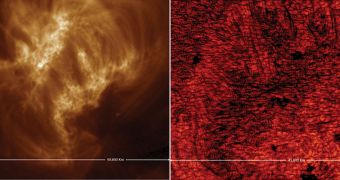Solar physicists have recently used the NASA Solar Dynamics Observatory (SDO) and the Big Bear Solar Observatory's (BBSO) New Solar Telescope (NST) to study the upper atmosphere of the Sun, called the corona. Their research revealed the presence of ultrafine loops of material within this layer.
Figuring out the dynamics of material within the Sun is essential for understanding how the star works. While making out large-scale structures is a relatively straightforward process, small formations can remain hidden for a long time.
This was made obvious by the new investigation, which revealed a type of formation that physicists did not even suspect existed. They knew of larger loops of material connecting the Sun to its corona, but the presence of the thinner loops had never been proposed before.
It was only through the use of the SDO/NST combo that the movements of material on the Sun could be tracked with sufficient precision to reveal their presence. Experts now plan to refine their measurements of this phenomenon, in order to figure out the role it plays on the solar surface.
One of the most interesting properties of the thin structures is that they are connected to the wider loops, which are located at higher altitudes. Experts want to use the telescopes to figure out how temperatures rise throughout the solar corona.
“We're used to seeing magnetic loops on the Sun. But we've never seen ones lying so low, that were so cold, or that were so narrow. These loops are 10 times narrower and at least 10 times cooler than the higher loops often seen by SDO,” expert Philip Goode explains.
The researcher holds an appointment as an investigator at the New Jersey Institute of Technology (NJIT), in Newark, New Jersey. He is also a coauthor of a new paper detailing the findings, which is published in the May 1 issue of the esteemed Astrophysical Journal.
“There have been many suggestions over the years as to what mechanism can make the atmosphere a thousand times hotter than the surface of the Sun. They basically come in two categories,” he argues.
“The first is that there's some kind of continuous magnetic energy adding heat. The second is that there's an impulsive, intermittent movement that adds heat. And there are, of course, all kinds of variations and mixtures of each theme,” Goode says.
This line of study could help establish which of the two theories is the most likely to be correct.

 14 DAY TRIAL //
14 DAY TRIAL //